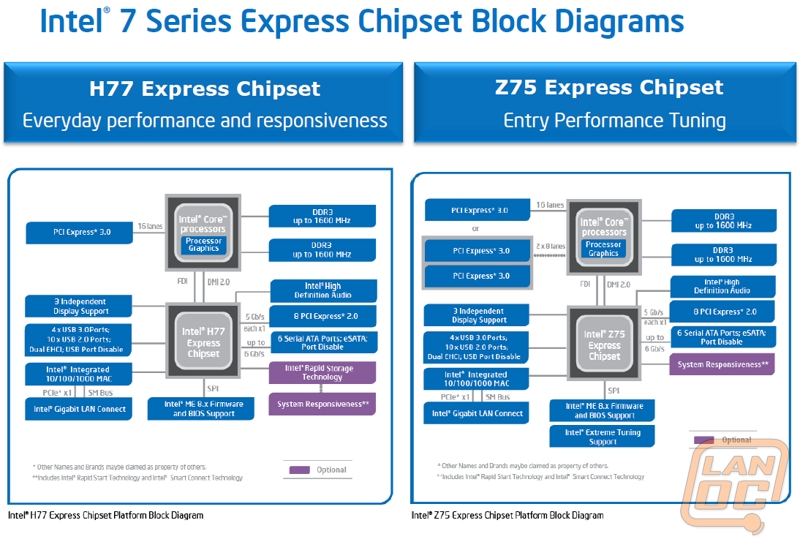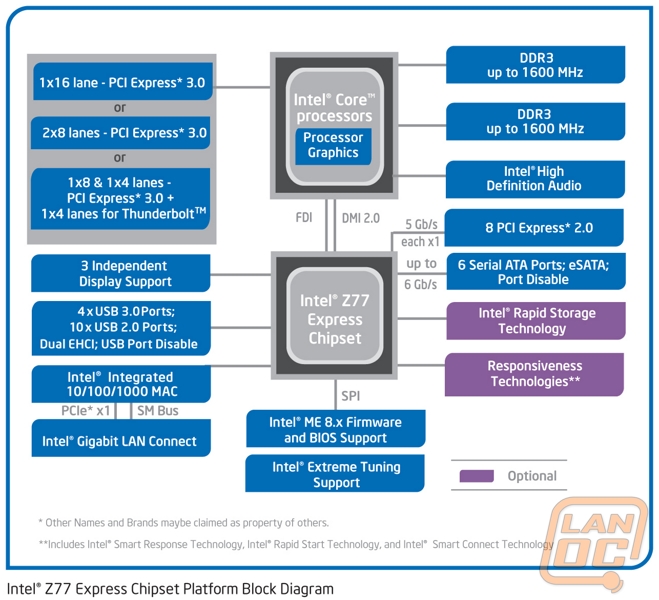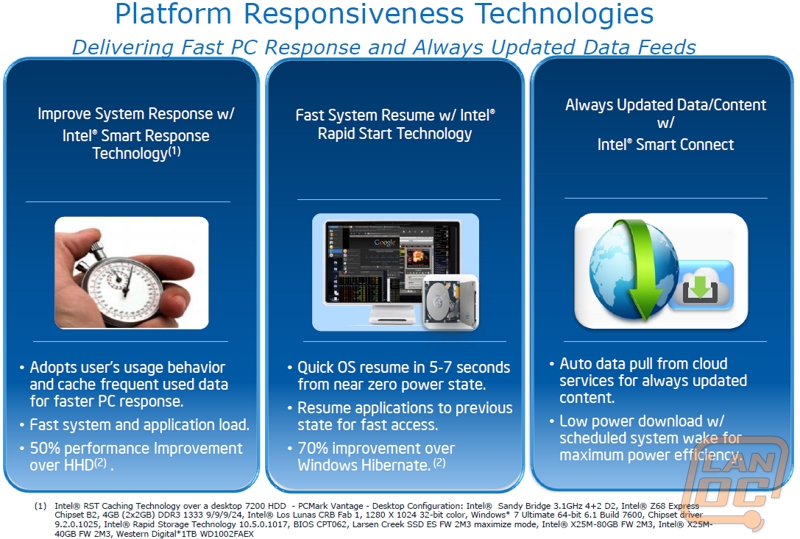 Intel has officially announced their newest chipset for socket 1155, the Z77. With H61, H67, P67, and Z68 chipsets still on the market, it may seem bewildering that Intel would introduce yet another beast to the field. In addition, Z77 is one of six new chipsets introduced in Intel's new 7 series chipset, Panther Point. What does the Panther have to offer that its predecessors did not? Though Intel may have just announced Z77, we've had our hands on sample boards for the past several weeks, putting them to the LanOC test, and we can finally share what we've found. We'll start with Intel's own Z77 board, the DZ77GA-70K as well as coverage of the Panther Point chipsets.
Intel has officially announced their newest chipset for socket 1155, the Z77. With H61, H67, P67, and Z68 chipsets still on the market, it may seem bewildering that Intel would introduce yet another beast to the field. In addition, Z77 is one of six new chipsets introduced in Intel's new 7 series chipset, Panther Point. What does the Panther have to offer that its predecessors did not? Though Intel may have just announced Z77, we've had our hands on sample boards for the past several weeks, putting them to the LanOC test, and we can finally share what we've found. We'll start with Intel's own Z77 board, the DZ77GA-70K as well as coverage of the Panther Point chipsets.
Product Name: Intel DZ77GA-70K
Review Sample Provided by: Intel
Preview by: Wes and Adam
Pictures by: Wes
Intel 7 Series Chipset (Panther Point) Details
As discussed before, one of the largest differences between the 6 and 7 series is support for USB 3.0, which looking at the table below we see up to 14 USB ports available on both series, with the 7 series including up to 4 USB 3.0 ports as opposed to straight 2.0 on the predecessor. What this translates to is a faster communication from chipset to processor. Though we've seen USB 3.0 on boards previous to the launch of Panther Point, they were made possible through use of a third-party controller. When a controller is involved, it creates a middle-man of sorts, requiring that controller to communicate with the chipset, which then communicates to the processor. Those four USB 3.0 ports supported directly on the chipset can skip that third step and talk directly to the processor, which means faster performance.
|
Item |
6 Series |
7 Series |
|
CPU Support |
Sandy Bridge |
Sandy Bridge |
|
CPU I/F |
DMI 2.0 |
DMI 2.0 |
|
Package |
MB: 25 x 25 mm, DT: 27 x 27 mm |
MB: 25 x 25 mm, DT: 27 x 27 mm |
|
USB |
14 USB 2.0 |
14 USB Ports (Up to 4 USB 3.0 ) |
|
PCIe |
8 PCIe 2.0 |
8 PCIe 2.0 |
|
Storage |
2 SATA Gen 3, RAID, 4 SATA Gen 2 |
2 SATA Gen 3, RAID, 4 SATA Gen 2 |
|
PCI |
DT: 4 slots |
DT: PCI on B/Q skus only |
|
Display I/Fs |
VGA, LVDS, DP, HDMI (w/ cost reduced LS), Wireless Display |
VGA, LVDS, DP, HDMI (w/ cost reduced .LS), Wireless Display |
|
Display Pipes |
Dual Independent. Display Digital I/Fs |
Three Independent. DisplayDigital I/Fs |
|
Security |
PAVP |
PAVP |
|
Manageability & FW |
ME 7.0 |
ME 8.0 |
|
iRST |
10.0 and 10.5 (Intelligent caching and Optical Read Ahead) |
11.0 w/Intelligent caching |
|
LAN |
GbE MAC |
GbE MAC |
|
Integ. Clock |
Yes |
Yes |
Along with the Z77 chipset, which is featured on the board we are previewing here, Panther Point will introduce five other SKU's to complete the 7 series. As you can see below, these are classified between mainstream, corporate, and the full-featured Z77. There are a few small differences between the 6 SKUs, including performance tuning available on only those SKUs targeted for, as you may have guessed, performance: the Z75 and Z77.
|
Features |
H77 |
Z75 |
Z77 |
B75 |
Q75 |
Q77 |
|
Processor Support / Socket |
LGA 1155 |
LGA 1155 |
LGA 1155 |
LGA 1155 |
LGA 1155 |
LGA 1155 |
|
CPU Performance Tuning |
- |
X1 |
X1 |
- |
- |
- |
|
Processor Graphics Overclocking |
X |
X |
X |
X |
X |
X |
|
Switchable Graphics (Dynamic Muxless Solution)2 |
X |
X |
X |
X |
X |
X |
|
Built-in Visuals |
X |
X |
X |
X |
X |
X |
|
Intel® Rapid Storage Technology 11 |
X |
X |
X |
X |
X3 |
X |
|
Intel® RST Smart Response Technology4 |
X |
- |
X |
- |
- |
X |
|
Intel® Smart Connect Technology |
X |
X |
X |
X |
X |
X |
|
Intel® Rapid Start Technology |
X |
X |
X |
X |
X |
X |
|
Intel® Wireless Display /Music |
X |
X |
X |
X |
X |
X |
|
3 Independent Displays |
X |
X |
X |
X |
X |
X |
|
Intel® Active Management Technology 8.0 |
- |
- |
- |
- |
- |
X |
|
Intel Standard Manageability |
- |
- |
- |
- |
X5 |
X5 |
|
Intel® ME Firmware 8.0 SKU6 |
1.5MB |
1.5MB |
1.5MB |
5MB |
5MB |
5MB |
|
2012 vPro |
- |
- |
- |
- |
- |
X |
|
2012 SIPP7 |
- |
- |
- |
- |
X |
X |
|
PCIe Configuration |
1X16 |
1X16 or 2X8 |
1X16 or 2X8 or 1X8 +2X4 |
1X16 |
1X16 |
1X16 |
|
Total USB Ports (Max USB3 Ports) |
14 (4) |
14 (4) |
14 (4) |
12 (4) |
14 (4) |
14 (4) |
|
PCI Express 2.0 (5 GT/s) |
8 |
8 |
8 |
8 |
8 |
8 |
|
Legacy PCI |
- |
- |
- |
X |
X |
X |
|
SATA Ports (Max# 6Gb/s) |
6(2) |
6(2) |
6(2) |
6(1) |
6(1) |
6 (2) |
Regardless of the SKU, all of the 7 series not only supports USB 3.0, but all support a maximum of four ports, with the small business B75 chipset two USB 2.0 short of the rest. Though the 7 series chipset is capable of PCI Express 3.0, the speed is limited to PCI Express 2.0 while using Sandy Bridge based processors. Similarly, each SKU has at least one available SATA 6.0Gb/s ports, while the majority of the chipset, including H77, Z75, and Z77 support two, with four left for SATA 3.0Gb/s.


In addition to the newly added 7 series SKUs, the chipset is also backwards compatible with processors that worked with the 6 series chipset; in other words Sandy Bridge based CPUs.
The chipsets also included a few new software features, such as Intel's Smart Response Technology, Rapid Start Technology, and Smart Connect, which adapt to the user's behavior as well as aid in over all response and resume from hibernation or stand-by.


